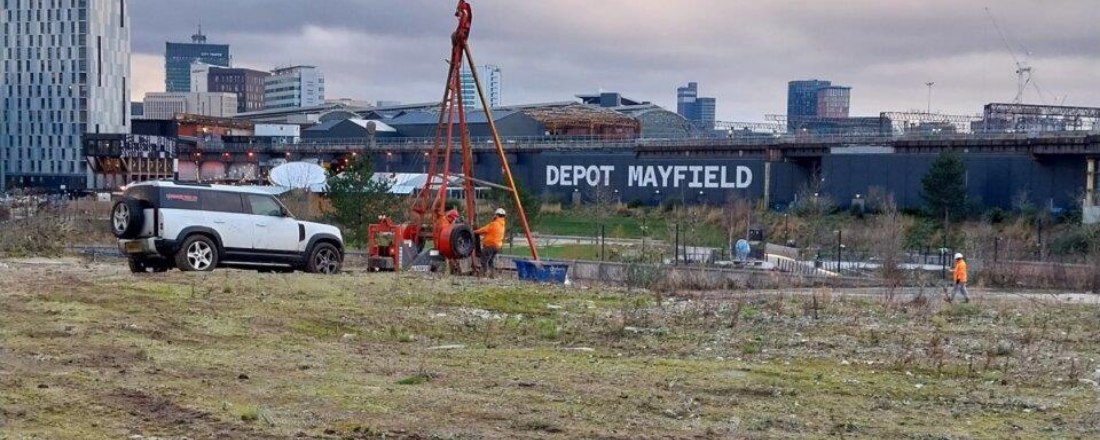Get updates from The Developer straight to your inbox Yes, please!
“Don’t treat soils like dirt” say experts highlighting waste on construction sites
In one teaspoon of soil, there are more living organisms than people on the planet and yet we dispose of it like rubbish, reports Kimberley France
Watch the session by Dan Matthews, Earth & Geoconsultancy Director, Civic, and Jess Davies, Professor of Sustainability, Lancaster University Environment Centre at Festival of Place: Climate Resilience
The UK sent 29.5 million tonnes of soil to landfill in 2018, disposing of £1.5million-worth of resources. Soil is not only important to biodiversity and greenspace, but also a critical carbon sink. In just the top three metres of soil, there’s more carbon than in all the forests, animals, plants and the atmosphere combined.
Reflecting on the severity of wastage by the construction industry at Festival of Place: Climate Resilience, a two day digital event, speakers Dan Matthews, Earth & Geoconsultancy Director, Civic, and Jess Davies, Professor of Sustainability, Lancaster University Environment Centre, delved into how soil has been overlooked.

“It all starts with the soil,” says Davies. Yet, soil isn’t free to perform its normal function. In the 1800s, the water cycles operated naturally, even in towns and cities, falling to the ground and finding its way back to rivers and streams where water levels rose slowly. Now, with 50% of the ground sealed under buildings or hard standing, and increasing storm severity, the water gushes, overflowing sewer networks and discharging large quantities of surface water all at once, causing rapid flooding and a rising threat.
“If you live in Bermondsey and Old Southwark, 90% of those (buildings) could be in danger of flooding by 2050,” says Matthews highlights. “It’s really not that far way. What this is clearly showing is that it’s a very real and legitimate threat.”
We can reduce the strain on the surface water networks with rain gardens and permeable green spaces. But this won’t tackle the neglect of soil as a valuable resource: 6.1 million tonnes of soil was lost due to development in 2013. The disposal, compaction or destruction of soil during construction are wasting a material which contains three times the amount of carbon in all of the world’s coal, oil and gas reserves.
“It’s really important that we retain the soil organic carbon stocks that we have, particularly in areas where they’re high such as old grassland or woodland," says Matthews.


Once damaged, stripped, compacted or sent to landfill, there’s little to be done to return carbon and biodiversity to the soil. Davies presses that it can take up to 1,000 years to produce just a few centimetres of soil, essentially making it a non-renewable resource.
With soil containing nearly 60% of the planet’s biodiversity, Davies is keen to raise awareness about what’s in the ground under our feet.
Working with a team from Lancaster University, Davies co-founded a taskforce to establish a model policy on how soils can be preserved during construction, bring together scientific evidence of the damage caused by current soil treatment with informed best practice:
“If we can consider soils at that first stage, it means we have the most opportunities to protect and promote good soil management.”
The ambition is to get planners to integrate soil health into local plans from the get-go to influence the whole development process: “We’re trying introduce the concept of soil and landscape-led design on our projects to put soil on the agenda at an early stage in the development,” says Matthews.
There are several opportunities to integrate soil into existing policies and by understanding what exists on a site and the soil quality before anything else allows management and protection of the soil.
The Local Soils Model Policy and Guide was created in partnership with Lancaster City Council and Cornwall Council. Participants in the engagement acknowledge being surprised by the degree to which soil mattered to the environment.
Find out more:
Watch the talk in the video above, discover The Local Soils Model Policy and Guide or download Dan Matthews’ slides and Jess Davies’ slides.
Checkout more talks from Festival of Place: Climate Resilience and other events in the Talks Library. Please note, you will be asked to register for free if you’re not already signed in.
If you love what we do, support us
Ask your organisation to become a member, buy tickets to our events or support us on Patreon
Sign up to our newsletter
Get updates from The Developer straight to your inbox
Thanks to our organisation members
© Festival of Place - Tweak Ltd., 124 City Road, London, EC1V 2NX. Tel: 020 3326 7238


